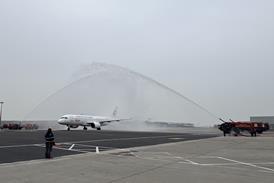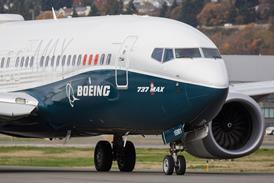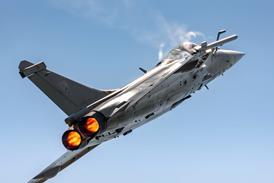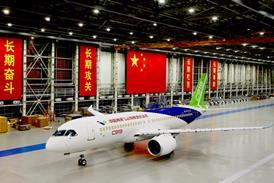When your nearest neighbour is 10 days away by boat, aviation is fairly important. But the central Pacific Micronesians are finding that no island can afford to ignore the economics of running an airline. As economic reality forces island governments to cut their support, local airlines are learning that they must balance the essential service they provide against commercial constraints. The result is a restructuring of aviation in the region.
Micronesia is a series of dots sprinkled along the equator, mostly on its north side between Hawaii and the Philippines. Strategically located, these islands have grown in importance since the second world war, due to tourism and commercial fishing. Guam and nearby Saipan are both administered by the US, but all the other islands in this vast ocean now govern themselves. The Marshall Islands, Federated States of Micronesia, and Palau are former US wards. Trust territories managed by Britain, Australia and New Zealand have become the republics of Nauru and Kiribati (pronounced Kir-e-bas); the latter was the old Gilbert and Ellis Islands.
Stepping stones between east and west, the islands of Micronesia have few links to their South Pacific neighbours. Air traffic flows mostly east-west between Hawaii and Guam and from Guam and Saipan to points throughout Asia.
To span these seas, three airlines operate beyond their home islands. Each is at a different point along a scale ranging from shrinkage to growth. At the small end is Air Marshall Islands, which has shrunk and may shrink further before finding its equilibrium. Farther along is Air Nauru, which recently stopped downsizing, has restructured, and is starting to think again about growth. At the opposite end of this scale is Continental Micronesia, which has grown from strength to strength to become even more dominant and profitable.
Continental Micronesia, formerly known as Air Micronesia or simply 'Air Mike,' has been hopping through these islands since 1968. Nauru, which Air Mike never served, launched its own airline long ago. The Marshall Islands, which Air Mike does serve, started its own flag carrier eight years ago. Both Air Nauru and Air Marshall Islands are government owned. As recent events show, that may be their biggest challenge.
Take the case of Air Marshall Islands. Serving only 60,000 residents on 17 atolls, AMI used to fly a leased DC-8 between Honolulu and Majuro, the republic's capital, plus an HS.748 on an island hopper flight south to Fiji, and several small turboprops for local service. The Majuro government allotted the airline a $1.5 million annual subsidy, which local officials justified as a reasonable price to pay for independence from Continental Air Micronesia.
But mounting national debts and declining aid following independence created a growing fiscal crisis. In early 1996 Majuro slashed pay for government workers, froze hiring, and cut its subsidies to a government-owned copra plant and power company as well as to AMI, which had become the government's biggest black hole. Tom Ryan, a New Zealand consultant brought in as interim airline manager, faced an immediate need to downsize. He could foresee growing losses because of AMI's purchase of a Saab 2000 in 1995 and its commitment to buy a second one in 1996.
Ryan bit the bullet and managed to convince the airline's government board, chaired by Marshall Islands President Kabua, that the time had come to cancel the unprofitable Honolulu flights, end the DC-8 lease, sell the HS.748, seek a regional joint venture to operate the Saab 2000, and defer delivery of the second Saab. Faced with mounting debts, the government agreed, albeit reluctantly.
Since then Ryan has been trying to implement that plan while searching for his own successor. Finding a new manager has taken longer than planned - Ryan was slated to leave last October - but he predicts success early this year. In the meantime, Saab has leased the second AMI Saab 2000 to Regional Airlines of France until August 1997, and AMI is leasing the first to a South Pacific airline, Air Vanuatu, for one day per week. The carrier is still trying to sell the HS.748.
AMI is still talking about some form of cooperative use for one of the Saabs. The original idea was for the Marshall Islands, Nauru, Tuvalu, and Kiribati to buy the second Saab together and either operate it jointly or lease it to a jointly owned airline. More recently, the proposed partners are three South Pacific airlines. The first Saab still flies only 4.5 hours a day, though Saab says reliability has now reached 98.7 per cent; there had been problems relating to an inadequate spares holding and condensation in instrument panels.
Air Marshall Islands will not discuss its current finances, but donor countries and agencies recently met with Marshall Islands officials at the Asian Development Bank and praised their government for cutting its workforce, balancing its 1997 budget, and reducing losses at Air Marshall Islands. Independent reports on AMI's condition are mixed. With the airline's chairman in poor health, no homes found yet for surplus aircraft, and the airline still looking for a permanent manager, it is certainly too early to declare its troubles over.
By contrast, that is effectively what Air Nauru's new CEO has done. Air Nauru also shrank from a seven-jet fleet and routes all over the Pacific. Today it has only one Boeing 737-400 and one south-north route arcing from Melbourne-Brisbane-Nauru to Pohnpei-Guam-Manila, with short branches to Fiji and Kiribati.
Phosphate mining made Nauru so rich that it used to pay no heed to commercial concerns. It scheduled flights for island neighbours simply because they seemed to need them. If local fishermen were lost at sea, Air Nauru would cancel flights, load anxious aunts, uncles and cousins aboard a Boeing 727, and fly a low level search for hours while the family drowned its worries at the open bar.
How much did all this cost? No one is really sure. 'Air Nauru was simply a department of government operated on a cash basis,' explains its new chief financial officer, Eddie Dufrenne. 'It was just topped up whenever it ran low,' adds Rex Banks, the new chief executive officer, who guesses annual losses ranged from $10 million to $24 million.
Like Air Marshall Islands, Air Nauru was its government's single biggest expenditure, but that did not matter until the phosphate started running out. With declining royalties, things came to a head quickly when $180 million in bonds came due early last year and the government could not pay them. Banks closed the overseas account because of overdrafts. The government enlisted Price Waterhouse to help devise a strategy for paying debts and adjusting to a more frugal future.
Nauru began to sell overseas assets and tighten its belt. It retained Peter Roberts, an Australian aviation consultant with Pacific island experience, with directions to 'make Air Nauru more commercial.' Roberts promptly sold one of the airline's two remaining jets, slashed unprofitable routes, and gave the surviving B737-400 a workhorse load of scheduled and charter flights totalling 4,200 hours a year.
Roberts also prepared Air Nauru for corporatisation, which took effect when he completed his contract and left in mid-1996. The airline transferred all assets to a new government-owned corporation and the Nauru government agreed to assume all existing debts except the B737 lease. Rex Banks postponed his New Zealand retirement to become the new CEO and help select other senior managers.
In his first six months Banks focused on the big problems - filling gaps in the B737's utilisation following the end of an important charter, offering promotional fares to test the size of the discretionary market, starting a yield management system, renegotiating the fuel supply, and ferreting out deals that were hurting Air Nauru. 'Everyone's been ripping them off something shocking,' Banks says. 'I'm getting a real buzz out of saying: "Hang on, it's me now, and this is not going to happen anymore." '
In January Air Nauru plans to let Qantas lease its B737 three days a week for domestic Australian routes. That will boost utilisation to 4,500 annual hours and guarantee enough added revenue for Banks to predict: 'We will be cash positive by the end of February and just barely profitable by 30 June.' That is two years ahead of Peter Roberts' forecast.
Banks thinks Air Nauru's downsizing days are over. 'It's impossible to make the airline really profitable with only one aircraft.' In the next several months he plans to seek approval to trade in the B737-400 for two B737-700s in the next two to three years. With that extra capacity he hopes to use existing air rights to launch a new service from Nauru to Hawaii, while also seeking fifth freedom rights from various Micronesian islands directly to Asia. In part, he is hoping to emulate the success of Continental Micronesia in flying planeloads of tourists to Guam and Saipan from big Asian markets, but he also sees untapped niches among some lesser known islands. 'For people who have been around the world 10 times, I believe this area is going to develop in the next five years.'
Nearly 30 years ago, when Continental launched its Micronesian division, Air Mike also concentrated on inter-island traffic. Most of its passengers were US officials or Peace Corps volunteers. Then Air Mike gained traffic rights from Guam and Saipan to Japan, and the airline has never been the same since. 'Japan is now the backbone of our company,' says Jim Ream, who was Continental's vice president finance before moving to Guam to become Continental Micronesia's president last October. Flights to Japan from Guam, Saipan and Honolulu now account for 70 per cent of the airline's business, Ream estimates.
The inter-island share of this business has dropped to only 10-15 per cent, Ream says. Islanders are still flying at the same rate, but they simply have not kept pace with the throngs of inbound Japanese tourists or the growing traffic from what Ream calls the 'developing markets' of South Korea, Taiwan and Hong Kong.
This market boom has turned Continental Micronesia into a substantial airline; it carried 2.56 million passengers in 1995, when its revenue of US$741.6 million was nearly half as much again as the $505.8 million generated in 1991.
Ream declines to comment on the company's profitability. The US Department of Transportation's Form 41 database credits the airline with a net profit of $67.3 million on revenues of $785.6 million in 1995, but the discrepancy between the airline's and the DOT's revenue data suggests that the profit figure should be used with caution.
Continental Micronesia has applied for routes to three more Japanese cities and for more capacity on some existing routes, but all requests are frozen for now in the broader bilateral impasse between Tokyo and Washington. Ream says US negotiators offered a side deal on Micronesia; their Japanese counterparts proposed a slightly broader 'beach deal' including Hawaii, but the Americans balked at settling Hawaii routes separate from broader issues between the two countries.
Meanwhile, Continental Micronesia is pushing ahead with plans to boost capacity on existing Japanese routes. In the first quarter of this year it plans to upgrade all flights to Tokyo, Osaka and Nagoya to widebodies, using two more B747s wet-leased from Continental. In early 1998, when four recently ordered B757s arrive, Ream plans to replace all B727s on the secondary Japanese routes to Fukuoka, Sendai and Sapporo. Beyond that, he is studying whether to upgrade the other Asian routes to B757s, and whether to hushkit the B727s used for inter-island routes or replace them with B737s. Guam and Saipan have the same Stage 2 phase-out schedule as in the US; Japan's deadline is 2002.
Continental Micronesia may also revive the Sydney route it dropped early last year because its DC-10 was too big for that market. Next year or the year after, it will probably try again with a B757. 'Like every other carrier, there's a shortage of airplanes and we'll go into the markets that look the best,' Ream says. 'Sydney stands out as an obvious one.' The airline has also applied to serve Vietnam.
Unlike its other island counterparts, Continental Micronesia has never been government owned. It answers to Continental Airlines, which owns 91 per cent of its stock; local investors own the rest. As a result of Continental's bankruptcy, in 1992 the Micronesian carrier changed from a Continental division into the separate corporation called Continental Micronesia, Inc.
Ream claims Continental's control is more nominal than real. 'On an operational level, this is very much a stand alone company, given our location on the other side of the world and the unique differences between our markets,' Ream explains. But Continental wet-leases the B747s to its Micronesia affiliate and handles legal, finance and pension management, as well as heavy maintenance.
Last July Continental Micronesia, which has a better financial track record than Continental itself, assumed $160 million of its parent's debt to allow Continental to shed restrictive covenants imposed with Chapter 11 financing. Ream defends this refinancing on the grounds that it also cut Continental Micronesia's interest rate by some 250 basis points on an equal amount of debt.
'We got a better amortisation schedule and ended up with a much lower weighted cost of capital.' Ream insists that policies made in Houston do not set strategy on Guam. 'I only need to convince my board that my decisions are strategically sound,' he says. 'We do everything on a straight-up economic basis.'
No other islands in Micronesia could feed or sleep the some million visitors who fly to Guam or Saipan every year. But each of Micronesia's airlines is learning that it must fit itself to its markets and come closer to making all its decisions on such a 'straight-up' basis.
Source: Airline Business























